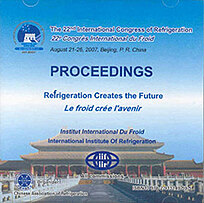
Document IIF
Développement d'un nouveau système déshydratant destiné à une pompe à chaleur à compression de vapeur : développement d'un système prototype.
Development of a new drying system applying a vapour-compression heat pump: development of a prototype system.
Auteurs : KONABE A., KUROBE I., TOYOSHIMA S., et al.
Résumé
The purpose of this paper is to introduce a new type of a drying system, which could improve the demerits of the conventional drying equipment. In the system developed, a vapour-compression heat pump is applied to utilize the exhaust heat from a condenser to heat wet material from the bottom of a closed chamber to generate vapour in the closed chamber. The vapour is dehumidified by an evaporator of the refrigeration cycle - consisting of a so-called heat recovery type drying system. As a refrigerant of the heat pump, R-410A is used, therefore, the new system is free from ozone depletion. Since in the developed system, it is possible to dry by the condensing temperature, there is no possibility of denaturing material. In order to compare the performance of the system developed, the authors compared it with a conventional hot-air system with an electric heater. As a result of the comparison, the system developed has been proven to consume less than about 1/3 of the electrical energy of a conventional system and to contribute thus to the prevention of global warming.
Documents disponibles
Format PDF
Pages : ICR07-E2-86
Disponible
Prix public
20 €
Prix membre*
Gratuit
* meilleur tarif applicable selon le type d'adhésion (voir le détail des avantages des adhésions individuelles et collectives)
Détails
- Titre original : Development of a new drying system applying a vapour-compression heat pump: development of a prototype system.
- Identifiant de la fiche : 2007-2802
- Langues : Anglais
- Source : ICR 2007. Refrigeration Creates the Future. Proceedings of the 22nd IIR International Congress of Refrigeration.
- Date d'édition : 21/08/2007
Liens
Voir d'autres communications du même compte rendu (839)
Voir le compte rendu de la conférence
Indexation
- Thèmes : Autres applications des pompes à chaleur
- Mots-clés : R410A; Déshumidification; Comparaison; Vapeur; Conception; Prototype; Séchage; Pompe à chaleur; Experimentation
-
High-temperature heat pump for resinous timber ...
- Auteurs : MINEA V.
- Date : 02/05/2005
- Langues : Anglais
- Source : 8th IEA Heat Pump Conference 2005: global advances in heat pump technology, applications, and markets. Conference proceedings [CD-ROM].
Voir la fiche
-
Constraints on the performance of dehumidifier ...
- Auteurs : CARRINGTON C. G., SUN Z. F., BANNISTER P., CHEN G.
- Date : 01/09/1997
- Langues : Anglais
- Source : Heat Pump Systems, Energy Efficiency, and Global Warming.
- Formats : PDF
Voir la fiche
-
A heat pump dryer using carbon dioxide as worki...
- Auteurs : SCHMIDT E. L., KLÖCKER K., FLACKE N., et al.
- Date : 19/09/1999
- Langues : Anglais
- Source : 20th International Congress of Refrigeration: Refrigeration into the Third Millennium.
- Formats : PDF
Voir la fiche
-
Use of heat pumps for grain drying.
- Auteurs : GENUTIS A.
- Date : 02/06/1993
- Langues : Anglais
Voir la fiche
-
Design of medium temperature dehumidifier systems.
- Auteurs : CARRINGTON C. G., BANNISTER P., BANSAL B., SUN Z. F.
- Date : 20/08/1995
- Langues : Anglais
- Source : For a Better Quality of Life. 19th International Congress of Refrigeration.
- Formats : PDF
Voir la fiche
